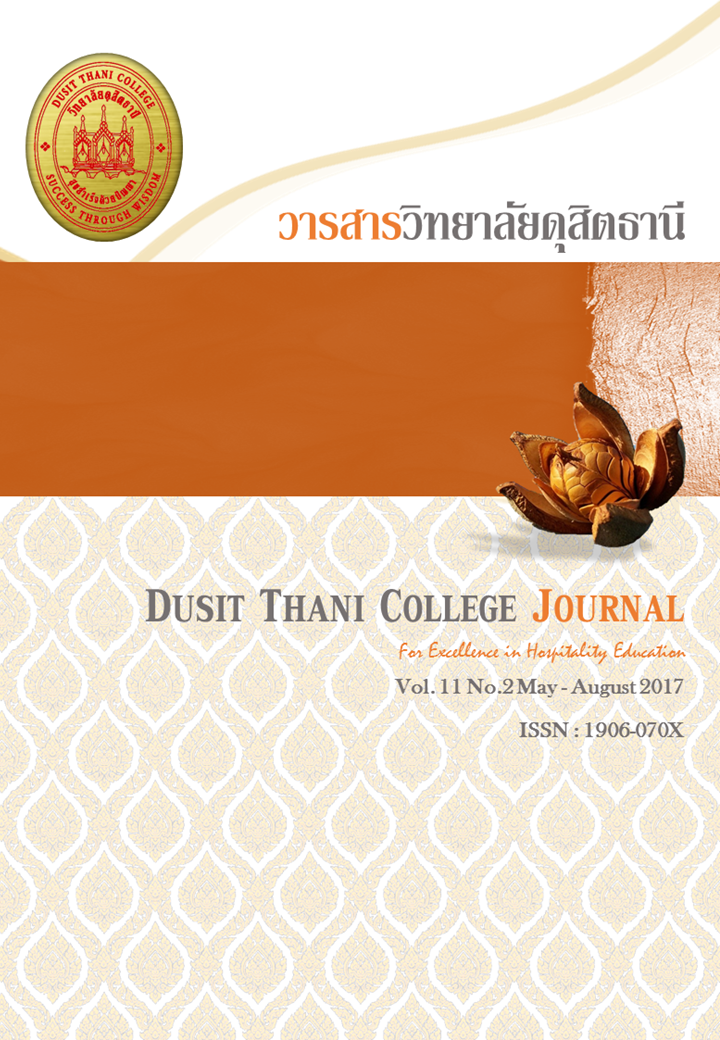Conceptualization of Mixed-Alternative Tourism Development in a Community: A Case Study of Thakam Sub-district, Chacheongsao Province
Main Article Content
Abstract
Tourism developers are consistently creating new tourism products in response to social dynamic changes. We are now in the era of insufficient resources due to growth of global population. Careless consumption of tourism resources is currently not ideal. Instead, primitive tourism products should be developed in terms of value adding, no more investing in massive amount of money. This article is a study of an attraction, which consists of various tourism resources, in Thakam sub-district, Bang Pakong District, Chacheongsao province. The study implied that not only primitive tourism resources were able to continue to be new products, but also new alternative tourism activities are ultimately created for the community. It was concluded in the study that the concept of mixed-alternative tourism would ultimately useful to many attractions with the same characteristics. Specific researches should be conducted to hosts and guests over the complexities of generating sustainable development.
Article Details
Article Screening Policy
- All research and academic articles to be published must be considered and screened by three peer reviews in the relevant field / article.
- All articles, texts, illustrations and tables published in the journal are the personal opinions of the authors. Editors don't always have to agree. And no responsibility whatsoever is the sole responsibility of the author.
- The articles to be published must never be published. Where did you first publish? And not in the consideration of other journals If the audit found that there has been a duplicate publication It is the sole responsibility of the author.
- Any article that the reader sees as being plagiarized or impersonated without reference. Or mislead the work of the author Please let the journal editor know it will be your greatest blessing.
References
CTH diploma in tourism management: Special interest tourism study guide. (2011). London: BPP Learning Media.
Drumm A., Moore A. (2002). An introduction to ecotourism planning (Volume l). In Ecotourism Development: A Manual for Conservation Planners and Managers, 96. USA: n.p.
Kiper, T. (2013). Role of ecotourism in sustainable development. In M. Özyavuz (Eds.), Advances in Landscape Architecture. N.P.: n.p.
Kiper, T., Özdemir, G., Saglam, C. (2011). Environmental, socio-cultural and economical effects of ecotourism perceived by the local people in the northwestern turkey: kıyıköy case. Scientific research and essays. N.P.:n.p.
Prince, S., Loannides, D. (2017). Contextualizing the complexities of managing alternative tourism at the community-level: A case study of a nordic eco-village, Tourism Management, 60, 348-356
P. Wudthisin, Ex-chief inspector general of department of marine and coastal resources. (2017). (personal communication, February 28, 2017)
Thongsukdee, S., Et all. (2007). Irrawaddy dolphin (Orcaella brevirostris) in the Bangpakong river mouth, Thaksin university journal, , 10(1): 65 – 71
S. Wudthisin, Sage Villager and Committee of agriculture, commodity and food standards: White perch. (2017). (personal communication, February 28, 2017)
Thakam sub-district annual report. (2015).
Accessed on February28, 2560, http://www.thakam.go.th/data.php?menu_id=38
12th National economic and social development plan: 2017-2021. (2560). Office of the national economic and social development board.


